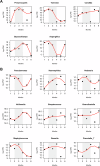Pneumocystis jirovecii is a potential pivotal ecological driver contributing to shifts in microbial equilibrium during the early-life lower airway microbiome assembly
- PMID: 40229539
- PMCID: PMC11997204
- DOI: 10.1038/s42003-025-07810-9
Pneumocystis jirovecii is a potential pivotal ecological driver contributing to shifts in microbial equilibrium during the early-life lower airway microbiome assembly
Abstract
Early life gut microbiota is being increasingly recognized as a major contributor to short and/or long-term human health and diseases. However, little is known about these early-life events in the human microbiome of the lower respiratory tract. This study aims to investigate fungal and bacterial colonization in the lower airways over the first year of life by analyzing lung tissue from autopsied infants. The fungal and bacterial communities of lung tissue samples from 53 autopsied infants were characterized by Next-Generation Sequencing (NGS), based on universal PCR amplification of the ITS region and the 16S rRNA gene, respectively. Our study highlights a high degree of inter-individual variability in both fungal and bacterial communities inhabiting the infant lung. The lower respiratory tract microbiota is mainly composed of transient microorganisms that likely travel from the upper respiratory tract and do not establish permanent residence. However, it could also contain some genera identified as long-term inhabitants of the lung, which could potentially play a role in lung physiology or disease. At 3-4 months of age, important dynamic changes to the microbial community were observed, which might correspond to a transitional time period in the maturation of the lung microbiome. This timeframe represents a susceptibility period for the colonization of pathogens such as Pneumocystis. The asymptomatic colonization of Pneumocystis was associated with changes in the fungal and bacterial communities. These findings suggest that the period of 2-4 months of age is a "critical window" early in life. Pneumocystis jirovecii could be a potential pivotal ecological driver contributing to shifts in microbial equilibrium during the early-life lower airway microbiome assembly, and to the future health of children.
© 2025. The Author(s).
Conflict of interest statement
Competing interests: The authors declare no competing interests. Ethics approval and consent to participate: The Ethics Commission for Studies in Human Subjects of the University of Chile´s School of Medicine approved this study under protocol CEISH #092-2013.
Figures








References
MeSH terms
Substances
LinkOut - more resources
Full Text Sources

